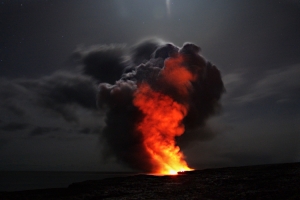“Where’s the kaboom? There was supposed to be an Earth-shattering kaboom!” Marvin The Martian

“At last, after two thousand years of research, the Illudium Q-36 Explosive Space Modulator.”
Marvin The Martian
Many out there claim to know what’s going on with the whole digital revolution we’ve all been talking about. And they may have an inkling about some of the changes. But none of us really know. My gut feeling is that most of us are still waiting for the giant KABOOM, where everything changes, and the world is very different than we know now. Will it ever happen? And if so, when? I believe it will. And it’s closer than we think. And the transformation will be bigger than we have ever dreamed. Truly, we could have an Earth-shattering kaboom.
Think back in the 90s, we were all buzzing about what the Internet would do. The Internet seemed like a magical place, and it would soon transform our world. Early in the 2000s, we were still talking about how it would “very soon” transform our world. And in some ways it has, industries have suffered (newspapers, booksellers) and others have grown (Facebook, Google, Amazon). But how we conduct commerce is just little sparks from the fuse. Much of what we see today is aimed at making a better website and spreading your brand though social media channels. We’re all still talking about how mobile technologies will create even more change – soon. Always “just down the road… this is the year!” The digital revolution is transforming the way we interact with brands… but really nothing transformative has happened to the world. We still live, work and travel much the same way we did 20 years ago. The marketing world is still rolling along, producing ads, in one form or another.
All the little changes, better technology, smart phones, digital boarding passes, are just signs that the fuse has been lit… soon there must be a giant kaboom.
“The Earth? Oh, the Earth will be gone in just a few seconds.” Marvin The Martian
Most people still think of digital marketing as a website linked with Twitter, Facebook and perhaps LinkedIn. But that is not accurate anymore. I pointed out few years ago: “The new market leaders in the next several years will be determined by how well firms embrace the information flow that surrounds their own brand and their customers’ lives.”
The impact of harnessing this information flow in real time has already been seen – just look at how the Obama campaign used just some of the tools emerging online. WSJ Columnist and former Reagan speechwriter Peggy Noonan wrote, regretfully, on how the Obama campaign used digital and information to run circles around the Romney campaign:
“I referred to a recent hiring notice from the Obama 2012 campaign. It read like politics as done by Martians: The ‘Analytics Department’ is looking for ‘predictive Modeling/Data Mining’ specialists to join the campaign’s ‘multi-disciplinary team of statisticians,’ which will use ‘predictive modeling’ to anticipate the behavior of the electorate. ‘We will analyze millions of interactions a day, learning from terabytes of historical data, running thousands of experiments, to inform campaign strategy and critical decisions.’
This struck me as “high tech and bloodless.” I didn’t quite say it, but it all struck me as inhuman, unlike any politics I’d ever seen. It was unlike any politics I’d ever seen. And it won the 2012 campaign. Those “Martians” were reinventing how national campaigns are done. They didn’t just write a new political chapter with their Internet outreach, vote-tracking data-mining and voter engagement, especially in the battleground states. They wrote a whole new book. And it was a masterpiece.”
“This makes me very angry, very angry indeed.” Marvin The Martian
I imminently realized that the Obama campaign was using the “information flow” in a way no one had before. I was gobsmacked. Here we always think of the marketing and advertising industry as the leaders in innovation, and a political campaign was running circles around most of the industry.
And I think this is just a small sign of things to come: the fuse on the Illudium Q-36 Explosive Space Modulator has been lit! What happens when all this access, all these tools, are free to use and creating new ways to interact, all to a new generation of consumer that is just starting to head out to the workplace?
Digital is no longer an add-on to a campaign. It drives all activities.
The digital revolution has created most of the changes we’ve seen to date by increasing the speed of, well, everything: from access to data, to creating content, to production, to tracking, and just about everything else. The increased speed of access combined with the ability to create timely brand messages (see Oreo’s Super Bowl power outage reaction as example #1) is has dramatically changed the marketing landscape. And it’s only the beginning. As clients continue to decrease the time to market and as competitive pressures increase, agencies must be able access that information flow and develop effective messages on the fly. When the day comes that everything is “digital” you will tap into huge reservoirs of content, consumer information, news, trends, data and producing branded messages in real time, the world as we know it will be gone. It will be gone in one giant Earth-shattering digital kaboom.
This is just the beginning – ad agencies better adapt.
What we’ve seen so far is minimal compared to the sweeping changes down the road. Today, most agency clients struggle with competitive pressures, a myriad of media options and the need to establish a more intimate conversation with consumers. They are constantly looking outside for help. Traditional ad agencies are now competing with smaller information-driven shops that provide more timely and cost-effective solutions, and newly created or unbundled data and media firms that provide higher quality, lower cost solutions. Strategic consulting firms are providing clients with business building ideas and new ways to reach their audience. As a result, the traditional agency’s position with the advertiser is eroding – just as more and more money is being invested in marketing. Read up on the marketing chessboard to best figure out where and how to move.
The advertising industry is at a critical juncture. It’s more than just the effective utilization of digital, but how when everything is digital what that means to the entire world of marketing – from idea to execution to connecting with consumers. Marketing firms must find new ways to harness the power of information to influence the consumer, integrate its existing client base and attract new business. The alternative is to let the industry’s core business continue to erode by adding little or no value to the process. The giant KABOOM are digital technologists, the Marvin the Martians, taking over the marketing world.
Final Thought
While the point of this article was to just point out how some of the new digital tools are radically changing marketing, several people that I sent this to wondered if I had any ideas on just how transformative the digital changes really would be. They point out that I don’t outline what I think the so-called kaboom really is… So let me state clearly, I think we’re just like a bunch of farmers at start of the industrial revolution, all standing around looking at a knitting machine, and not realizing the overall impact of mechanization will be on our daily lives. Digitization will be the same. Profound epic change. The digital conversations and branding efforts are the knitting machine; good, fun, but little change on daily life and how we work.
The kaboom? Combine big data with easy to use tools to sort and find anything, on anyone, about everything, a generation of kids raised with these tools, add cheap digital manufacturing, endless bandwidth and storage, and more virtual sharing of daily lives and very soon the world will be very different then what we see now. Much like the farmer standing by the knitting machine suddenly waking up in the 50s and seeing huge factories, highways, cars, TV and more. Perhaps you need to adjust your digital marketing strategy?
Will TV channels still be around after we can all access any form of entertainment at anytime, anyplace? Will big cities still be viable when people can easily live and work virtually? How will China survive when all our little cheap consumer goods can be produced on demand locally? Faster and cheaper? Combine these ideas and shake, as we truly have no idea.
A very different world… indeed.
Photo by doctor-a


